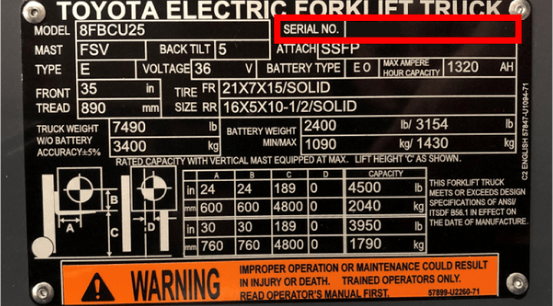Falken Tire Customer Story
Tread Lightly
Toyota forklifts make light work of lifting and moving racks of heavy tires at Falken’s New Jersey distribution center
When one enters the Falken Tire Distribution Center in Robbinsville, New Jersey, the person is immediately met with a sea of black. Tires upon tires stacked floor to ceiling in specialized racks—as many as 450,000 roadworthy products can be stored in the 218,000-square-foot facility at any given time. Most of them appear to look alike, but there are actually about a thousand different types held throughout the building in the large five- by five-foot racks, which are stacked six levels high up to 30 feet. The metal racks make it easy to group specific SKUs and allow for easy movement throughout the facility using Toyota forklifts. This facility is one of five in the Falken network and serves customers in the Northeast, the Mid-Atlantic states, and Canada.
There are 13 Toyota forklifts that make up the fleet in Robbinsville fulfilling Falken Tire’s warehouse forklift needs—10 electric and three propane vehicles. They do all of the heavy lifting of the racks and their contents, which can weigh over 2,000 pounds apiece when full of tires. The forklifts, with their 5,000-pound capacity, can lift two of the racks stacked together.
Falken chose Toyota forklifts for their durability and versatility. “We want the fork trucks to be able to go anyplace that we need to position them,” explains Jimmy Oxx, facility manager. “We are stacking six high in this building, which is unlike almost anywhere in the United States.” He says recent changes to the fire code allowed Falken to increase the height of the stack in the facility. The Toyota forklifts in Robbinsville feature quad masts that can reach as high as 260 inches. When fully extended, the trucks can easily place two racks stacked together on top of four other stacked racks to reach a height of six levels.
Where the Rubber Meets the Road
Most of the tires arriving at the facility are manufactured in Asia and come floor-stacked in 40-foot shipping containers. A forklift carrying an empty rack drives directly into a container. Workers then place tires onto the rack until full. The forklift next takes the rack to storage, with the location assigned according to the tire’s type, tread pattern, and size. Picking is performed into empty racks according to customer preference and SKU sequence. The forklifts then drive the racks into outbound trailers, where workers unload the tires for floor stacking.
Falken managers like being able to use the same forklift for work inside the containers and trailers as well as the storage and picking areas. “We worked with Toyota to build a machine that would handle the unique requirements of the building, given our aisle widths being as narrow as they are, with the stacking height being as high as it is,” says Ron Papcun, vice president of operations. “They have the flexibility to go inside a container in the unloading and loading processes, and we can use them on the dock. We can also use them in the picking and put-away operation because they have the height and capacity that we need to handle that requirement.”
The ability for the forklifts to maneuver in tight places and stack products high has enabled Falken to hold products more densely than it might otherwise be able to do. In fact, this facility stores tires at better than two tires per square foot, compared with the industry standard of 1.5 tires per square foot.
“That allowed us to shrink the size of the building,” adds Oxx. “The Toyota forklifts have been here for about a year, and I can tell you it’s really been a no-worry piece of equipment. From the purchase, to the men being able to acclimate themselves to it, to the support staff that we have from Toyota, it’s been a very rewarding experience,” he says.


